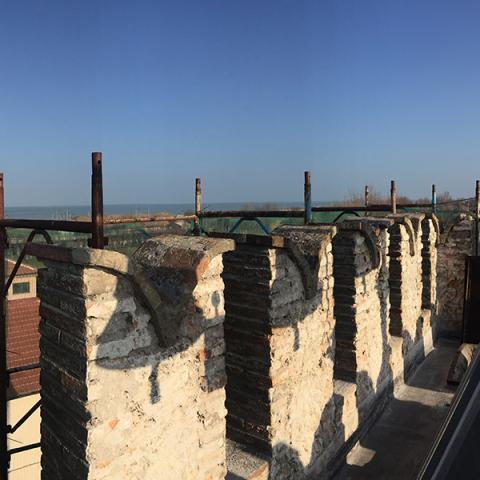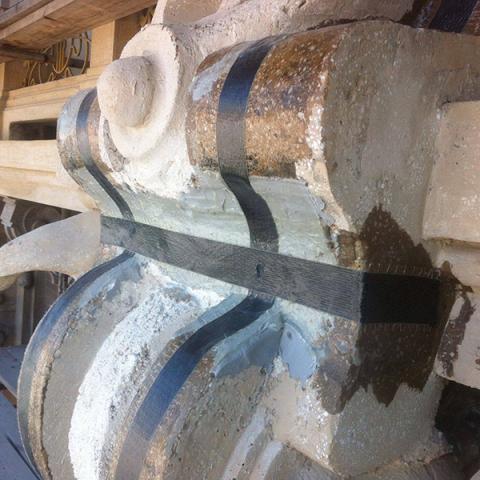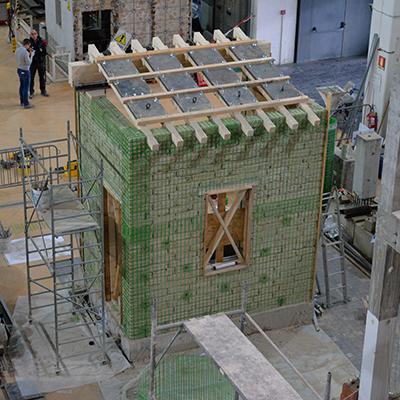info_1062
Consolidamento di merli in laterizio
Una torre merlata con funzione di cella campanaria costituisce il campanile di una chiesina nel centro storico di Fano. Nel corso di un intervento di consolidamento strutturale della torre, anche i merli sono stati oggetto di rinforzo ed hanno visto l’applicazione di C-MATRIX, un sistema in basso spessore FRCM – Fiber Reinforced Cementitius Matrix, che combina reti in composito con matrici di malta inorganica e un adesivo IPN a base acquosa come promotore di adesione.
Consolidation of brick battlements
A crenellated belfry constitutes the bell tower of a small church in the historic center of Fano. During the structural consolidation of the tower, the battlements were also reinforced with C-MATRIX, a low thickness FRCM system - Fiber Reinforced Cementitius Matrix- which combines composite meshes with inorganic mortar and the IPN, a water based addictive as adhesion promoter.

FRP PER IL CONSOLIDAMENTO DI ELEMENTI STRUTTURALI E DECORATIVI
Costruito all’inizio del ‘900 in stile Liberty, Palazzo delle Piane si presenta nel centro storico di Savona con una facciata in blocchi di finta pietra cementizia martellinata ed elementi decorativi di tipo naturalistico con foglie, animali e figure femminili. Un intervento di manutenzione straordinaria delle facciate ha visto l’impiego di elementi in CFRP per alcune mensole in cemento già rinforzate in passato con la posa di elementi in acciaio che, secondo la prescrizione della Soprintendenza, sono stati rimossi poiché invasisi ed antiestetici. Le fasciature in carbonio utilizzate hanno assolto alle richieste funzioni strutturali di presa in carico dei balconi rispettando i valori estetici della facciata grazie alle proprie caratteristiche che ne hanno consentito la posa senza essere visibili.
CONSOLIDATION OF STRUCTURAL AND DECORATIVE ELEMENTS THROUGH FRP
Palazzo delle Piane is located in the historic centre of Savona; built in the early 1900s its façade shows the typical decorative elements of the Italian Art Nouveau A structural restoration of the concrete decorated balconies has been done thorugh CFRP wrapping; in the past those elements had already been reinforced with steel elements which have been now removed according to the prescription of the Superintendent. Thanks to its characteristics the carbon wrapping has fulfilled both the structural functions and the aesthetic values of the balconies, according to the original project design.

EVENTI SISMICI E MURATURE STORICHE
Gli eventi sismici degli ultimi anni hanno dato avvio a studi e ricerche per intervenire non solo sui danni conseguenti alle scosse ma anche per identificare modalità di messa in sicurezza per operare sull’ampio patrimonio edificato esistente, tutt’ora a rischio sismico. Oggetto di questo intervento è un progetto di ricerca condotto dall’Università di Roma Tre e dall’ENEA, e finanziato dal Ministero degli Affari Esteri e della Cooperazione Internazionale, volto allo sviluppo di tecnologie sostenibili del tipo “Composite Reinforced Mortar” per il miglioramento sismico delle strutture esistenti, anche storiche. Il progetto ha visto il concreto impegno di Fibre Net sui temi del consolidamento murario con materiali compositi. I test eseguiti su tavola vibrante su un provino in tufo con aperture irregolari, realizzato in scala reale e rinforzato con la tecnica dell’intonaco armato, applicata sul solo lato esterno della muratura. Il materiale utilizzato è una rete preformata in fibra di vetro GFRP con angolari e connettori sempre nello stesso materiale, abbinata ad una malta a calce a basse caratteristiche meccaniche (10 Mpa). Il “pacchetto di rinforzo” così configurato ha, da una parte, dimostrato l’efficacia di tale sistema di consolidamento a fronte di eventi sismici estremamente significativi, e dall’altro la possibilità di utilizzare materiali compatibili con caratteristiche di reversibilità interessanti anche in presenza di contesti edificati storici.
Seismic events and historical tuff–walls

